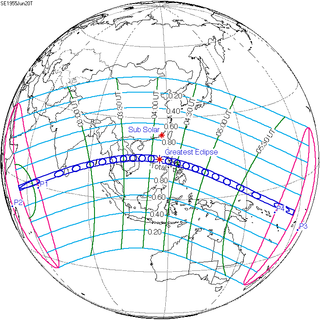Solar eclipse of June 20, 1955
| Solar eclipse of June 20, 1955 | |
|---|---|
| Type of eclipse | |
| Nature | Total |
| Gamma | −0.1528 |
| Magnitude | 1.0776 |
| Maximum eclipse | |
| Duration | 428 s (7 min 8 s) |
| Coordinates | 14°48′N 117°00′E / 14.8°N 117°E |
| Max. width of band | 254 km (158 mi) |
| Times (UTC) | |
| Greatest eclipse | 4:10:42 |
| References | |
| Saros | 136 (34 of 71) |
| Catalog # (SE5000) | 9410 |
A total solar eclipse occurred at the Moon's descending node of orbit on Monday, June 20, 1955,[1][2][3][4][5][6][7][8][9][10][11][12] with a magnitude of 1.0776. A solar eclipse occurs when the Moon passes between Earth and the Sun, thereby totally or partly obscuring the image of the Sun for a viewer on Earth. A total solar eclipse occurs when the Moon's apparent diameter is larger than the Sun's, blocking all direct sunlight, turning day into darkness. Totality occurs in a narrow path across Earth's surface, with the partial solar eclipse visible over a surrounding region thousands of kilometres wide. Occurring about 14.5 hours after perigee (on June 19, 1955, at 14:40 UTC), the Moon's apparent diameter was larger.[13]
With a maximum duration of 7 minutes 7.74 seconds, this is the longest solar eclipse of Saros series 136, as well as the longest total solar eclipse since the 11th century, and until the 22nd century, because greatest eclipse occurred near the equator.[14]
Totality began over the Indian Ocean, British Seychelles (today's Seychelles) and Maldives, crossing Ceylon (name changed to Sri Lanka later) including the capital city Colombo, Andaman Islands, Burma, Thailand including the capital city Bangkok, Cambodia, Laos, South Vietnam (now belonging to Vietnam), Paracel Islands and Scarborough Shoal (near the greatest eclipse), moving across the Philippines including the capital city Manila, Kayangel Atoll in the Trust Territory of the Pacific Islands (now belonging to Palau), Nukumanu Islands in the Territory of Papua New Guinea (today's Papua New Guinea), towards northern Ontong Java Atoll in British Solomon Islands (today's Solomon Islands) ending over Southwestern Pacific Ocean. A partial eclipse was visible for parts of South Asia, Southeast Asia, East Asia, Australia, and Oceania.
This was the second of four central solar eclipses visible from Bangkok from 1948 to 1958, where it is extremely rare for a large city to witness four central solar eclipses within 10 years.
Observations
[edit]The Tokyo Astronomical Observatory (now incorporated into the National Astronomical Observatory of Japan) of the University of Tokyo sent an expedition to Ceylon, but observation failed due to bad weather conditions. The Hydrographic Office of Japan (now Hydrographic and Oceanographic Department of Japan Coast Guard) sent a team to the western coast of Bình Thuận, Bình Sơn district, Quảng Ngãi province, South Vietnam. The whole process was not affected by any clouds or fog. The team said that totality of this eclipse was particularly dark compared with previous total solar eclipses observed, and the long duration of totality was also one of the reasons. The team took many images of solar corona successfully.[15] A small team from the United States observed the total eclipse from Thailand. Some members of the Thai royal family also saw the eclipse from Phra Nakhon Si Ayutthaya province, north of the capital city Bangkok. In addition, Radio Thailand also broadcast a special program on the total solar eclipse nationally, which was the first such broadcast in Thailand.[16]
Eclipse details
[edit]Shown below are two tables displaying details about this particular solar eclipse. The first table outlines times at which the moon's penumbra or umbra attains the specific parameter, and the second table describes various other parameters pertaining to this eclipse.[17]
| Event | Time (UTC) |
|---|---|
| First Penumbral External Contact | 1955 June 20 at 01:33:50.0 UTC |
| First Umbral External Contact | 1955 June 20 at 02:27:20.5 UTC |
| First Central Line | 1955 June 20 at 02:28:55.7 UTC |
| First Umbral Internal Contact | 1955 June 20 at 02:30:30.9 UTC |
| First Penumbral Internal Contact | 1955 June 20 at 03:25:02.8 UTC |
| Greatest Duration | 1955 June 20 at 04:08:34.6 UTC |
| Greatest Eclipse | 1955 June 20 at 04:10:42.0 UTC |
| Equatorial Conjunction | 1955 June 20 at 04:12:01.6 UTC |
| Ecliptic Conjunction | 1955 June 20 at 04:12:15.4 UTC |
| Last Penumbral Internal Contact | 1955 June 20 at 04:56:19.0 UTC |
| Last Umbral Internal Contact | 1955 June 20 at 05:50:53.2 UTC |
| Last Central Line | 1955 June 20 at 05:52:27.7 UTC |
| Last Umbral External Contact | 1955 June 20 at 05:54:02.2 UTC |
| Last Penumbral External Contact | 1955 June 20 at 06:47:35.0 UTC |
| Parameter | Value |
|---|---|
| Eclipse Magnitude | 1.07756 |
| Eclipse Obscuration | 1.16113 |
| Gamma | −0.15278 |
| Sun Right Ascension | 05h51m36.9s |
| Sun Declination | +23°25'50.7" |
| Sun Semi-Diameter | 15'44.3" |
| Sun Equatorial Horizontal Parallax | 08.7" |
| Moon Right Ascension | 05h51m33.5s |
| Moon Declination | +23°16'33.0" |
| Moon Semi-Diameter | 16'40.5" |
| Moon Equatorial Horizontal Parallax | 1°01'11.8" |
| ΔT | 31.2 s |
Eclipse season
[edit]This eclipse is part of an eclipse season, a period, roughly every six months, when eclipses occur. Only two (or occasionally three) eclipse seasons occur each year, and each season lasts about 35 days and repeats just short of six months (173 days) later; thus two full eclipse seasons always occur each year. Either two or three eclipses happen each eclipse season. In the sequence below, each eclipse is separated by a fortnight.
| June 5 Ascending node (full moon) | June 20 Descending node (new moon) |
|---|---|
 |  |
| Penumbral lunar eclipse Lunar Saros 110 | Total solar eclipse Solar Saros 136 |
Related eclipses
[edit]Eclipses in 1955
[edit]- A penumbral lunar eclipse on January 8.
- A penumbral lunar eclipse on June 5.
- A total solar eclipse on June 20.
- A partial lunar eclipse on November 29.
- An annular solar eclipse on December 14.
Metonic
[edit]- Preceded by: Solar eclipse of September 1, 1951
- Followed by: Solar eclipse of April 8, 1959
Tzolkinex
[edit]- Preceded by: Solar eclipse of May 9, 1948
- Followed by: Solar eclipse of July 31, 1962
Half-Saros
[edit]- Preceded by: Lunar eclipse of June 14, 1946
- Followed by: Lunar eclipse of June 25, 1964
Tritos
[edit]- Preceded by: Solar eclipse of July 20, 1944
- Followed by: Solar eclipse of May 20, 1966
Solar Saros 136
[edit]- Preceded by: Solar eclipse of June 8, 1937
- Followed by: Solar eclipse of June 30, 1973
Inex
[edit]- Preceded by: Solar eclipse of July 9, 1926
- Followed by: Solar eclipse of May 30, 1984
Triad
[edit]- Preceded by: Solar eclipse of August 18, 1868
- Followed by: Solar eclipse of April 20, 2042
Solar eclipses of 1953–1956
[edit]This eclipse is a member of a semester series. An eclipse in a semester series of solar eclipses repeats approximately every 177 days and 4 hours (a semester) at alternating nodes of the Moon's orbit.[18]
The partial solar eclipses on February 14, 1953 and August 9, 1953 occur in the previous lunar year eclipse set.
| Solar eclipse series sets from 1953 to 1956 | ||||||
|---|---|---|---|---|---|---|
| Descending node | Ascending node | |||||
| Saros | Map | Gamma | Saros | Map | Gamma | |
| 116 | July 11, 1953 Partial | 1.4388 | 121 | January 5, 1954 Annular | −0.9296 | |
| 126 | June 30, 1954 Total | 0.6135 | 131 | December 25, 1954 Annular | −0.2576 | |
| 136 | June 20, 1955 Total | −0.1528 | 141 | December 14, 1955 Annular | 0.4266 | |
| 146 | June 8, 1956 Total | −0.8934 | 151 | December 2, 1956 Partial | 1.0923 | |
Saros 136
[edit]This eclipse is a part of Saros series 136, repeating every 18 years, 11 days, and containing 71 events. The series started with a partial solar eclipse on June 14, 1360. It contains annular eclipses from September 8, 1504 through November 12, 1594; hybrid eclipses from November 22, 1612 through January 17, 1703; and total eclipses from January 27, 1721 through May 13, 2496. The series ends at member 71 as a partial eclipse on July 30, 2622. Its eclipses are tabulated in three columns; every third eclipse in the same column is one exeligmos apart, so they all cast shadows over approximately the same parts of the Earth.
The longest duration of annularity was produced by member 9 at 32 seconds on September 8, 1504, and the longest duration of totality was produced by member 34 at 7 minutes, 7.74 seconds on June 20, 1955. All eclipses in this series occur at the Moon’s descending node of orbit.[19]
| Series members 26–47 occur between 1801 and 2200: | ||
|---|---|---|
| 26 | 27 | 28 |
 March 24, 1811 |  April 3, 1829 |  April 15, 1847 |
| 29 | 30 | 31 |
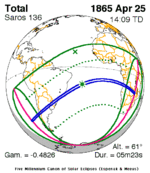 April 25, 1865 |  May 6, 1883 |  May 18, 1901 |
| 32 | 33 | 34 |
 May 29, 1919 |  June 8, 1937 |  June 20, 1955 |
| 35 | 36 | 37 |
 June 30, 1973 |  July 11, 1991 |  July 22, 2009 |
| 38 | 39 | 40 |
 August 2, 2027 |  August 12, 2045 |  August 24, 2063 |
| 41 | 42 | 43 |
 September 3, 2081 |  September 14, 2099 |  September 26, 2117 |
| 44 | 45 | 46 |
 October 7, 2135 |  October 17, 2153 |  October 29, 2171 |
| 47 | ||
 November 8, 2189 | ||
Metonic series
[edit]The metonic series repeats eclipses every 19 years (6939.69 days), lasting about 5 cycles. Eclipses occur in nearly the same calendar date. In addition, the octon subseries repeats 1/5 of that or every 3.8 years (1387.94 days). All eclipses in this table occur at the Moon's descending node.
| 22 eclipse events between April 8, 1902 and August 31, 1989 | ||||
|---|---|---|---|---|
| April 7–8 | January 24–25 | November 12 | August 31–September 1 | June 19–20 |
| 108 | 110 | 112 | 114 | 116 |
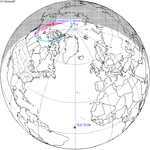 April 8, 1902 |  August 31, 1913 |  June 19, 1917 | ||
| 118 | 120 | 122 | 124 | 126 |
 April 8, 1921 |  January 24, 1925 |  November 12, 1928 |  August 31, 1932 |  June 19, 1936 |
| 128 | 130 | 132 | 134 | 136 |
 April 7, 1940 |  January 25, 1944 |  November 12, 1947 |  September 1, 1951 |  June 20, 1955 |
| 138 | 140 | 142 | 144 | 146 |
 April 8, 1959 |  January 25, 1963 |  November 12, 1966 |  August 31, 1970 |  June 20, 1974 |
| 148 | 150 | 152 | 154 | |
 April 7, 1978 |  January 25, 1982 |  November 12, 1985 |  August 31, 1989 | |
Tritos series
[edit]This eclipse is a part of a tritos cycle, repeating at alternating nodes every 135 synodic months (≈ 3986.63 days, or 11 years minus 1 month). Their appearance and longitude are irregular due to a lack of synchronization with the anomalistic month (period of perigee), but groupings of 3 tritos cycles (≈ 33 years minus 3 months) come close (≈ 434.044 anomalistic months), so eclipses are similar in these groupings.
| Series members between 1801 and 2200 | ||||
|---|---|---|---|---|
 August 28, 1802 (Saros 122) |  July 27, 1813 (Saros 123) |  June 26, 1824 (Saros 124) |  May 27, 1835 (Saros 125) |  April 25, 1846 (Saros 126) |
 March 25, 1857 (Saros 127) |  February 23, 1868 (Saros 128) |  January 22, 1879 (Saros 129) |  December 22, 1889 (Saros 130) |  November 22, 1900 (Saros 131) |
 October 22, 1911 (Saros 132) |  September 21, 1922 (Saros 133) |  August 21, 1933 (Saros 134) |  July 20, 1944 (Saros 135) |  June 20, 1955 (Saros 136) |
 May 20, 1966 (Saros 137) |  April 18, 1977 (Saros 138) |  March 18, 1988 (Saros 139) |  February 16, 1999 (Saros 140) |  January 15, 2010 (Saros 141) |
 December 14, 2020 (Saros 142) |  November 14, 2031 (Saros 143) |  October 14, 2042 (Saros 144) |  September 12, 2053 (Saros 145) |  August 12, 2064 (Saros 146) |
 July 13, 2075 (Saros 147) |  June 11, 2086 (Saros 148) |  May 11, 2097 (Saros 149) |  April 11, 2108 (Saros 150) |  March 11, 2119 (Saros 151) |
 February 8, 2130 (Saros 152) |  January 8, 2141 (Saros 153) |  December 8, 2151 (Saros 154) |  November 7, 2162 (Saros 155) |  October 7, 2173 (Saros 156) |
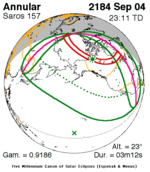 September 4, 2184 (Saros 157) |  August 5, 2195 (Saros 158) | |||
Inex series
[edit]This eclipse is a part of the long period inex cycle, repeating at alternating nodes, every 358 synodic months (≈ 10,571.95 days, or 29 years minus 20 days). Their appearance and longitude are irregular due to a lack of synchronization with the anomalistic month (period of perigee). However, groupings of 3 inex cycles (≈ 87 years minus 2 months) comes close (≈ 1,151.02 anomalistic months), so eclipses are similar in these groupings.
| Series members between 1801 and 2200 | ||
|---|---|---|
 September 28, 1810 (Saros 131) |  September 7, 1839 (Saros 132) | 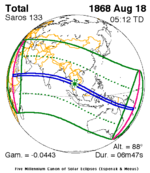 August 18, 1868 (Saros 133) |
 July 29, 1897 (Saros 134) |  July 9, 1926 (Saros 135) |  June 20, 1955 (Saros 136) |
 May 30, 1984 (Saros 137) |  May 10, 2013 (Saros 138) |  April 20, 2042 (Saros 139) |
 March 31, 2071 (Saros 140) |  March 10, 2100 (Saros 141) |  February 18, 2129 (Saros 142) |
 January 30, 2158 (Saros 143) |  January 9, 2187 (Saros 144) | |
Notes
[edit]- ^ "June 20, 1955 Total Solar Eclipse". timeanddate. Retrieved 5 August 2024.
- ^ "U.S. to Observe Eclipse of Sun April 8, 2024". Idaho State Journal. Pocatello, Idaho. 1955-06-21. p. 3. Retrieved 2023-10-17 – via Newspapers.com.
- ^ "Longest Eclipse In 1238 Years Lasts For Seven Minutes And Blacks Out An Area Of 1276000 Square Miles". The Lexington Herald. Lexington, Kentucky. 1955-06-21. p. 1. Retrieved 2023-10-17 – via Newspapers.com.
- ^ "Didn't See Eclipse? Catch The One In 2024". The World. Coos Bay, Oregon. 1955-06-21. p. 11. Retrieved 2023-10-17 – via Newspapers.com.
- ^ "Long Eclipse Seen In South China Sea Area". Troy Daily News. Troy, Ohio. 1955-06-20. p. 10. Retrieved 2023-10-18 – via Newspapers.com.
- ^ "Seven Minute Long Eclipse Darkens South China Seas". News-Pilot. San Pedro, California. 1955-06-20. p. 3. Retrieved 2023-10-18 – via Newspapers.com.
- ^ "CLOUDS BLACK OUT ECLIPSE IN CEYLON". Coventry Evening Telegraph. Coventry, West Midlands, England. 1955-06-20. p. 14. Retrieved 2023-10-18 – via Newspapers.com.
- ^ "Clouds black out eclipse". Hull Daily Mail. Hull, Humberside, England. 1955-06-20. p. 5. Retrieved 2023-10-18 – via Newspapers.com.
- ^ "In tears as cloud hides the eclipse". Birmingham Evening Mail. Birmingham, West Midlands, England. 1955-06-20. p. 9. Retrieved 2023-10-18 – via Newspapers.com.
- ^ "'Night' Fliers: Eclipse". Des Moines Tribune. Des Moines, Iowa. 1955-06-20. p. 3. Retrieved 2023-10-18 – via Newspapers.com.
- ^ "Clouds Spoil Ceylon Show: Harvard's Team Gets Best Look at Eclipse". The Boston Globe. Boston, Massachusetts. 1955-06-20. p. 8. Retrieved 2023-10-18 – via Newspapers.com.
- ^ "Clouds Favor Harvard Eclipse Lookout But Balk Hayden, German Photographing". The Berkshire Eagle. Pittsfield, Massachusetts. 1955-06-20. p. 1. Retrieved 2023-10-18 – via Newspapers.com.
- ^ "Moon Distances for London, United Kingdom, England". timeanddate. Retrieved 5 August 2024.
- ^ Fred Espenak. "Catalog of Solar Eclipses: 1001 to 1100". NASA.
- ^ Kuniji Saito. "Photometry of the Solar Corona at the Eclipse on June 20, 1955". Publications of the Astronomical Society of Japan. 8: 126–141. Archived from the original on 13 May 2020.
- ^ "SOLAR ECLIPSES IN SIAM (THAILAND)". National Astronomical Research Institute of Thailand. Archived from the original on 30 March 2016.
- ^ "Total Solar Eclipse of 1955 Jun 20". EclipseWise.com. Retrieved 5 August 2024.
- ^ van Gent, R.H. "Solar- and Lunar-Eclipse Predictions from Antiquity to the Present". A Catalogue of Eclipse Cycles. Utrecht University. Retrieved 6 October 2018.
- ^ "NASA - Catalog of Solar Eclipses of Saros 136". eclipse.gsfc.nasa.gov.


 French
French Deutsch
Deutsch